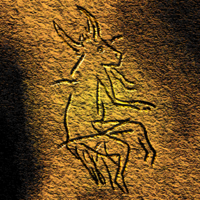Paleolithic religion

Imagine that a really long time ago - way before your grandparents or great-grandparents were even born - there were people living on the earth. These people lived very differently from the way we do now. They didn't have houses like we do, or cars and buses to get around. Instead, they had to hunt animals and gather plants to survive.
Now, imagine that these people also believed in things that they couldn't see or touch, but they thought were very powerful. They believed that some kind of spirits or gods controlled the world around them. They thought that these spirits could help or hurt them, depending on whether they pleased them or not.
These ancient people are called Paleolithic humans, and their religion is called Paleolithic religion. It's called that because they lived during what's called the Paleolithic era, a very long time ago. During this time, people had very basic technology and lived in small groups.
Now, imagine that these people had a special way of showing respect to their spirits and gods. They would make special paintings on the walls of the caves where they lived. These paintings showed things like animals that they hunted, or symbols that had special meanings for them. Sometimes, they would even carve small figures out of stone or bone, which they thought were magical.
Paleolithic humans also had special rituals that they thought would please their spirits and gods. For example, they might make offerings of food or jewelry to them, or dance and sing special songs. They might also have special ceremonies for things like childbirth or death, which they thought were very important events.
So, in summary, Paleolithic religion was the way that ancient humans expressed their beliefs about the world and the spirits or gods that they thought controlled it. They showed their respect and worshipped these spirits and gods through special paintings, carvings, rituals, and ceremonies. Even though we don't believe in the same things that they did, it's important to understand their beliefs and how they influenced the way these people lived.
Now, imagine that these people also believed in things that they couldn't see or touch, but they thought were very powerful. They believed that some kind of spirits or gods controlled the world around them. They thought that these spirits could help or hurt them, depending on whether they pleased them or not.
These ancient people are called Paleolithic humans, and their religion is called Paleolithic religion. It's called that because they lived during what's called the Paleolithic era, a very long time ago. During this time, people had very basic technology and lived in small groups.
Now, imagine that these people had a special way of showing respect to their spirits and gods. They would make special paintings on the walls of the caves where they lived. These paintings showed things like animals that they hunted, or symbols that had special meanings for them. Sometimes, they would even carve small figures out of stone or bone, which they thought were magical.
Paleolithic humans also had special rituals that they thought would please their spirits and gods. For example, they might make offerings of food or jewelry to them, or dance and sing special songs. They might also have special ceremonies for things like childbirth or death, which they thought were very important events.
So, in summary, Paleolithic religion was the way that ancient humans expressed their beliefs about the world and the spirits or gods that they thought controlled it. They showed their respect and worshipped these spirits and gods through special paintings, carvings, rituals, and ceremonies. Even though we don't believe in the same things that they did, it's important to understand their beliefs and how they influenced the way these people lived.
Related topics others have asked about:
